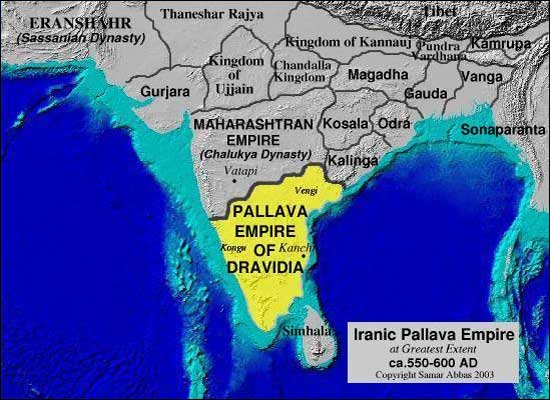The Pallavas were well known for their strong soldiers and it’s the one of the reason for the upswing of Pallava dynasty. They ruled over 500 years. Pallava dynasty conquered the region of Thondaimandalam that was located at Pallava Puri, then Pallava formulated their kingdom in the ruins of the eastern part of the kingdom of the Satvahanas. shortly there was a disaster that happened resulting in the Pallavas to move to Kanchipuram.
Pallava then gave rise to kanchi( modern Kanchipuram near Chennai) as their capital. Kanchipuram is distinguished for temples and area of Vedic learning. The Pallavas were the Dravidian country's emperors, and they quickly adopted Tamil culture.
Commercial business and a little amount of colonialism in Southeast Asia were hallmarks of their administration, although they inherited rather than initiated Tamil meddling in Ceylon.
They ruled at 4th century and spread its territories from Krishna river to pennar in the south, all the way across to vellary in the west. After which they conducted ashwametha yagam, Vedic rituals and was portrayed as supreme king of kings devoted to dharma.
During the period of 350 b.c to 575 bc there were 16 kings ruled. Among those rulers kandavarma was the strongest serving emperor. Kandavarma is the most powerful ruler who defeated the Pallava Dynasty , the Chalukyas (to the northwest) and the Pandya's (to the south).
The Pallavas fought the Lkshvakus in the 14th century A.D. and expanded their kingdom as far as the Krishna River.
Society
The society in South India was quite a cast depended one .
The position of Brahmins increased as the rulers gave lands to Temple and to other priests. The lesser castes were ruled by the Brahmins (priestly class) and Kshatriyas (warrior class). The followers of Lord Vishnu and Lord shiva was important at that time of Pallava dynasty. Kanchipuram became the prominent area of pilgrimage for Hindus and it is the capital of Pallavas and the center of study of Tamil and Sanskrit.
The temple is one of the administrative centers. Kanchipuram became a problem solving area where people come together as the temple has vast area.
Art
Temples at Mahabalipuram( well known as the Shore Temple) is carved out of one single rock at that time without any special instrument. It gained its own appreciation in ancient India when the Kailash Nath temple at Ellora was built in the 8th century.
Culture
Several poses of dance were painted on the walls of temples, caves, and even sculptures. It includes both men and women even group and individual poses. Those days dancing was a part of entertainment in the kings palace as well in temples.
Siva is portrayed in the dance called tandava. Dancing is one of the form of devotion or even worship. The cave temples' walls provided a glimpse into this art genre, with traces of bright hues visible i n the paint.
Because the Pallava dynasty utilized vegetable dyes, the colours available were limited, although they included red, yellow, green, and black.
The kailasanatha temple consist of around fifty cells in the inner courtyard where it shows the traces of painting. Moreover, painting was the prime hobby for the Pallava dynasty. Music also takes place primarily in Pallava society.
The songs that were composed praised the deities and even rulers. The song are composed for rulers which speaks for the king's skill and intelligence.
The rise of the Rashtrakutas coincided with the decline of the Pallavas. In 890 AD, Vijayalaya, t he Chola ruler, defeated Aparajitavarma,, the last Pallava ruler.
Written By - Pratthiksha shree A
Edited By - Tushna Choksey











1 Comments
Pallavas are ethinic tamils
ReplyDelete